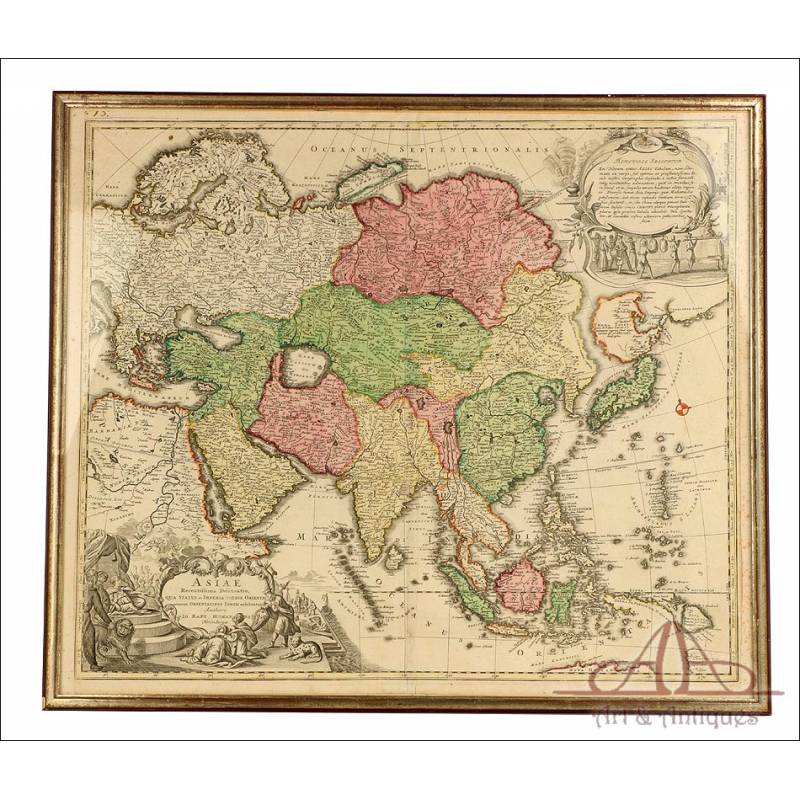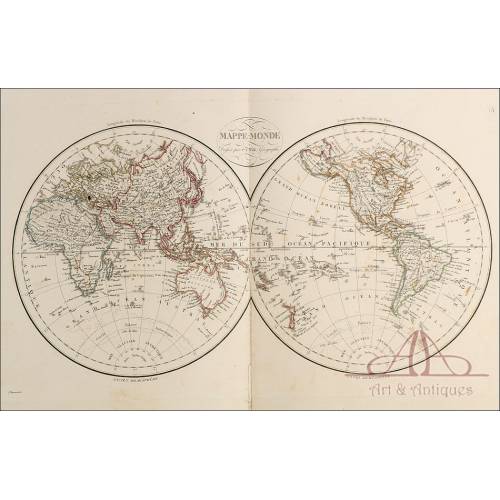D-002
Antique Map of Asia by Johann Baptist Homann. Germany, 1730
Wonderful map of Asia edited by Johann Baptist Homann in the 18th century. In amazing condition. Original from the time.
Striking antique map of Asia by Johann Baptist Homann printed in Nurnberg, Germany in 1730. The map is mounted on a vintage frame and is entirely original from the time. It is in really good condition and shows no torn or missing parts. It is big-sized and is printed in black ink with the countries adorned with pink, green, yellow and orange shades. It is an original work of a outstanding beauty: the engraving is full of lovely shadows and boasts a great attention to detail and a surprising precision, worthy of the great master that made it. At the bottom left corner we can see a gorgeous Latin cartouche that identifies the printed continent as Asia and includes the authors signature, Io. Bapt. Homann, as well as the city of printing, Nurnberg. The cartouche is located in the center of a scene which depicts the clichés about Asia which were common in those days: we can see exotic figures with turbans and curious outfits, wild animals, a sultan in his throne holding a scepterAt the opposite corner (top right) there is another scene full of exotic charm aimed to the Benevolent spectator. The maps frame is made of silver-leaf-covered wood and remains in good condition. This amazing antique map of Asia by Johann Baptist Homann will stand out in a dining room, study or library for its great manufacture and authenticity. Dimensions: Map: Width: 22.8 in / 57 cm. Height: 21.6 in / 54 cm. Frame: Width: 24.8 in / 62 cm. Height: 21.6 in / 54 cm. Johann Baptist Homann Biography The cartographer Johann Baptist Homann was born in Oberkammlach, Bayern in 1664. Though in the beginning he was trained to be a churchman, after he converted to the Protestantism he left the career and started working as a notary. In a few years he grew an interest in etching and cartography and in 1702 he founded his own printing and editorial. Eventuall, Homann would become one of the most prestigious cartographers in Germany. He was designed Imperial Geographer by the emperor Charles VI, a feature which would increase his popularity and fame. In 1716 Homann published what is considered his masterwork, the Great Atlas of the Whole World. He also made and printed many maps in collaboration with the engraver Christoph Weigel the Old. Homann died in Nurnberg in 1724, but his company remained active until 1848 under the name Homann Erben (Homann Inheritors).











